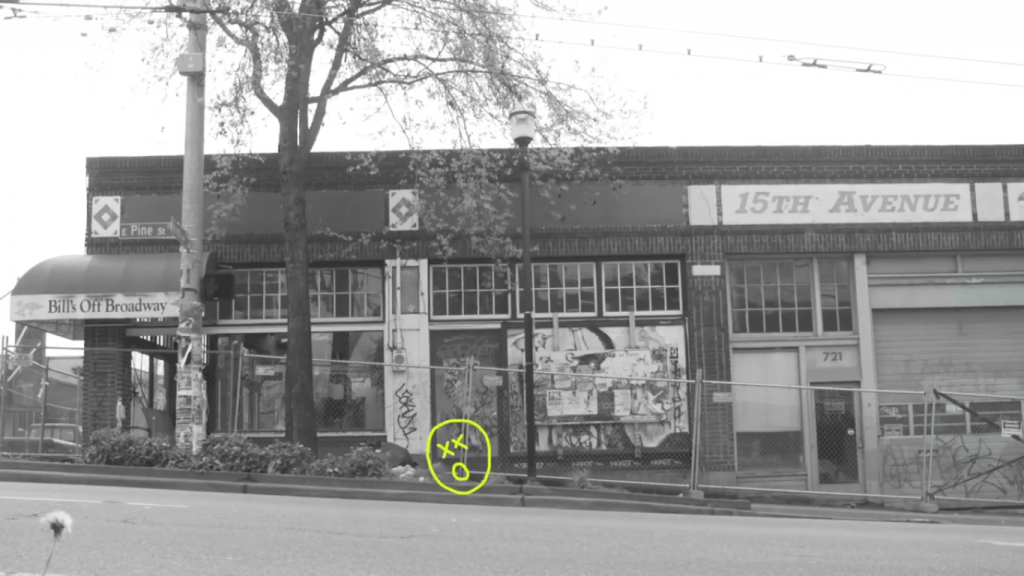Design Review Goof: Important Meeting for Builders on Wednesday, December 9
I’ve decided that my tombstone will have the following latin phrase carved into it: DIXI VOBIS. That roughly (and I was terrible at Latin so I welcome edits) translates to, “I told you so!” Dealing with members of the City Council, City Staff, “urbanists,” and press has taught me to keep careful track of what they say and what they do because often, we have to say, “I told you so.” In fact, from reading history I’ve learned that there really wouldn’t be any history at all if it weren’t for people charging headlong into things they were strenuously advised not to do. The latest example is section 8 of so called Omnibus legislation passed by the Council a few months ago.
8. Design review pursuant to Section 23.41.014 is required for a development proposal on a lot that is contiguous with one or more qualifying lots and the combined size of development proposals on the subject lot and contiguous qualifying lot or lots exceeds thresholds in Table A or Table B to Section 23.41.004. For purposes of the preceding sentence, a “qualifying lot” is a lot for which, at the time a complete application is submitted for a development proposal on the subject lot, a complete Master Use Permit or building permit application for a development proposal has been submitted but a project pursuant to that permit 4 has not received a final certificate of occupancy.
We asked the Council to consider handling concerns of a few of Councilmember O’Brien’s constituents through the City’s process of looking at ways to improve design review. What this section was intended to stop was builders dividing their projects in ways that would avoid design review. We’ve already discussed why this occurs: design review adds costs and hassles to housing that just increase housing prices and reduce supply often with little or no benefit. We said this would lead to unintended consequences, especially killing projects that would be providing needed housing. Here’s an architect on this section:
As an architect specializing in multi-family housing, I do a few townhouse projects each year. Clients pick our firm because they are willing to spend a little more time and effort on design in order to get better results. They are more willing than most to accept a little extra time and risk in order to get a better outcome. Almost all of our projects go through the streamlined design review process, but I can tell you for a certainty that my clients will do whatever is necessary to stay out of the full design review process. The reason is simple. While the hassle, cost and uncertainty of the process is an annoyance factor, it is not the primary reason for avoiding design review. The reason is the time. The DRB process can add over a year to the entitlement timeline of a small process, bumping an 18 month timeline to a 30 month timeline.
Why is the so important? The reason is simple. The for-sale housing market is quite volatile. Prices can move up or down fairly quickly in a short period of time. Skilled prognosticators feel they can predict market trends a few months out, but not much further. As the timelines become longer, the element of risk becomes unacceptable to the point where investors will not back the project. Townhouses are a for-sale product that can be sold at a profit but does not rent for enough to pay for the cost of construction. If a builder gets to the end of a project and discovers that the housing market has shifted under their feet and they cannot sell for enough to pay back the bank, they do not have the option of hanging on for a better market. The way to manage this risk is to keep project timelines as short as possible. This is not a trivial issue for spec developers. This is the whole shebang.
For the reasons outlined above, it is unlikely this legislation will capture more projects in full Design Review as intended. Instead, the most likely outcome will be a suppression of builders ability to deliver new homes into a housing market that saw 18% price appreciation last year due to the supply shortfall of new housing. This is a policy that will almost certainly fail to achieved its intent, but with plenty of collateral damage. I urge you to reconsider. Please feel free to call me if you would like to discuss [emphasis is mine].
Of course, the Council ignored these concerns passing the Omnibus in spite of our efforts to amend the legislation out of the proposal which failed on a 7 to 2 vote.
Not only will this limit housing production, nobody at the City or within the development community is certain that this provision is legal or how to comply or enforce it. By it’s very nature, the amendment forces some projects to go through full design review simply because another totally unrelated project is next door. City staff are doing the best they can to try and understand how this might impact projects. Some builders might find themselves suddenly dealing with full design review on a project premised on not having to go through full design review. This could likely kill the project and the housing with it, something NIMBYs want anyway.
So this Wednesday, December 9th at 6pm at University Heights Community Center, Room #209, we’ll gather with staff from the Department of Planning and Development to try and figure out how builders can understand the impact of this legislation and how to work through it to get their projects and much needed housing built. Hopefully, in the coming year, we can get this provision repealed before too much damage is done. Maybe with some examples and support from City staff, “I told you so,” can become, “Thanks for listening.”
Tacocat: Looking at Growth With Humor and Optimism
The This whole week has been cat themed and that was not planned, honest. And so, to keep it consistent, the last post of the week is also about a cat, Tacocat, a Seattle band with a video about new development on Capitol Hill. To be accurate, the song lyrics to Bridge to Hawaii (2014) aren’t really discernibly about development at all, but the video has this hook on You Tube:
Seeking an escape from dreary Seattle weather and a favorite neighborhood that is rapidly being torn down and condo-fied, Tacocat create a DIY Hawaiian vacation in Lelah’s rad Jeep in this new video for “Bridge to Hawaii” from Tacocat’s acclaimed album NVM, out now on Hardly Art records.
The Tracker in the video belongs to one of the most creative people I know, Tacocat’s drummer, Lelah Maupin. Maupin and I have talked before about the choices artists have to make in life in general but also in Seattle in specific to keep doing art. Housing is just one of many expenses artists face along with trying to find rehearsal an performance space. Visual artists, musicians, and theater groups, are very dependent on affordable real estate, and with growing demand for new housing and new commercial development options for bands and other artists are frequently limited.
The answer is not rent control. At a recent press conference I crashed, Councilmember Kshama Sawant was touting commercial rent control as a way to slow down the loss of space for artists. That’s the worse idea possible. Rent control would mean even higher prices as building owners and operators faced limited options for revenue to keep their space maintained or to improve space. The problem is scarcity, something created by bad legislation passed by the City Council (with the deciding vote cast by Councilmember Mike O’Brien) to limit retail space on the ground floor in new development in Capitol Hill.
The video has a sweet, funny, sad take on changes happening on Capitol Hill. Maupin in an interview describes the importance of humor to their music and lyrics,
“That’s been our thing the whole time, but maybe we didn’t know it until later,” says Maupin. “No one wants to hear anyone yelling or squawking ever again. It’s kind of a turn-off.”
“I think the way we communicate is to make jokes about things or be funny about it,” adds Maupin. “It feels like the best way to get our perspective out. Last night when I was going to sleep, I was listening to these Ram Dass lectures, and at the end of one he said, ‘I want to leave you with this: Don’t take yourselves too seriously.’”
Bridge to Hawaii does just that, taking a light hearted poke at growth on Capitol Hill but also at the endless drum beat of rain and dreariness in our city. Far from being an antidevelopment screed (“yelling or squawking”) the song offers a conceptual alternative: have some fun, even if it’s simply sitting a car and drinking fruity drinks with your friends. Just quit whining already about the inevitability of the damn rain — and growth. Seattle just needs to relax and have some fun with change.
And in one frame, the Tracker passes the iconic Bill’s Off Broadway, a beyond greasy spoon that has been the host of many late night come downs from people out on the Hill. Bill’s disappeared because of a new housing development that went into construction last year.
But guess what? Bill’s is back!
The new development included Bill’s back in and there is no reason we can’t find ways to be sure this happens with other redevelopment. We can have new housing and familiar businesses or spaces. Rent control for small retail spaces or other cultural hubs won’t work for the same reason it won’t work for apartments, it simply removes the incentive to create new innovative spaces. What the Council should do is undo the damage it did when it banned smaller spaces from the low-rise zones.
Seattle’s yellers and squawkers about growth could learn from Tacocat’s brand of optimism and humor: everything is going to work out in the end if we want it to. We do need a plan to create spaces for artists to do their work and to live. But there also needs to be some spontaneity and innovation in all zones of the city. Ram Dass also said, “Our plans never turn out as tasty as reality.”
Tacocat will be winding up their latest tour with a show at Neumos on December 13, 2015 at 8:00PM. You can get your tickets now at Neumos’ website.
Surprise! People Get Housing Supply and Demand at City Hall
There are times in meetings when someone says something that makes your jaw drop open. This week that happened to me. While in a meeting about a complex issue about how Seattle City Light gets service to properties that are being divided up into more than one parcel. It’s a complicated issue involving the City’s land use and electrical code, and, significantly, design review. Builders have been trying to build more housing and they have to divide lots in a way that would allow them to avoid design review. This saves substantial costs, but ends up triggering other problems including technical and legal difficulties getting City Light service to the multiple parcels. Here’s what a City staff person said, as a matter of fact, during the meeting on this topic:
Anytime builders under develop [to avoid design review] it’s bad for the city.
Wow! I jumped on that comment, saying that this is exactly what gets me up and motivated every single day: we need more housing! I want to note, however, that City employees not our enemy. On the contrary, City staff often end up having execute horrible policies imposed by, you guessed it, the Seattle City Council. And the staff person definitely meant city with a small “c,” recognizing the fact that when City regulators make rules that are so onerous that builders avoid triggering them, we lose vital housing supply in a market brimming with demand.
Anytime builders under develop [to avoid design review] it’s bad for the city.
But why is it that this simple observation, what some people would call “the truth,” is not the starting point of all housing policy and housing discussions taking place in Seattle? The answer is a complicated one, and it’s the reason why we have a housing “crisis.” Here’s my rough notes on why we can’t seem to deal with the housing issue from a basic principle that making more housing and more types of housing all over the city is good for prices and for sustainable growth.
The Conspiracy
“If we let developers build, they’ll just build more, expensive housing units nobody can afford.”
This almost sounds like the Yogi Bearism, “nobody goes there anymore, it’s too crowded.” We’ve been over this one again and again. There is no such thing as expensive housing, unless you’re talking about mansions in Beverly Hills. Even then, to a significant degree, like anything, housing gets expensive when it’s scarce and hard to build because of regulation.
The Trickle Down
“Building more market rate units is just another example of ‘Trickle Down Economics’ that was proven a failure under Ronald Reagan.”
This argument is all about what we often call “filtering,” the concept that when supply expands the newest housing units are, indeed, more expensive, however competition for older, cheaper units isn’t as intense meaning those units stay less expensive. Increasing supply of new housing options so landlords compete with each other for tenants rather than tenants bidding up scarce housing is just common sense. But it’s also economic fact, studied by people like Mike Scott who know the housing market. Calling it “Trickle Down Economics” is a rhetorical device to associate those of us who support more building of housing with Ronald Reagan, probably the least favorite President among Seattle voters.
The Threshold
“There will always be a threshold. We just have to live with it.”
This comes from both the City side and from our side of the discussion; general resignation. Even though avoiding expensive and time-consuming design review creates other problems that reduce housing supply (like the ones builders face with getting electricity to their site) there’s nothing that can be done about the broader problem. There is a lot of frustration among builders who face a myriad of rules and regulations that raise costs and lengthen the time it takes to get a project finished. Ignoring the impact of these costs on housing price can only happen when we ignore the basic principle that fewer housing units and higher costs means the disutility of higher housing prices for everyone, especially for poor people with less money to spend.
Because Social Justice and Equity
“In order to achieve social justice and equity and housing, developers have to be accountable and pay their fair share.”
This is, as I pointed out earlier this week, the idea that equity and social justice (whatever those things mean) can only be achieved at someone’s expense. That is, you can’t possibly have just outcome unless someone bad suffers negative consequences for what they’re doing to create injustice and inequality. Nevermind for the moment nobody can even define what these terms really mean, what’s important to some people in town is that new housing construction is a bad thing, an impact, that needs to be offset with–are you sitting down?–more housing! The social justice argument is a veil for the status quo in Seattle, and is built on the premise that what builders are doing is a bad thing. So what if more design review rules end up adding costs and slowing down projects; they deserve it.
It’s Politics
“It might be true that cutting back on things like design review would help lower housing prices, but that’s just not politically possible.”
The truth is that with leadership politics can change. By simply giving up and giving in and not raising the larger issue that City staff person raised, we’re for sure going to get more of the same. When we look at the math, we know design review adds costs to projects that get passed on to renters. When builders find ways to avoid these costs by building fewer units, they trade supply for efficiency. That’s the point of the City staff person’s important and truthful comment. If this fact isn’t presented to politicians as a consequence of their actions creating more design review requirements that make building housing more difficult, how can they be held accountable.
Whatever the excuse is for not making it part of the base calculation of how we consider housing policy in Seattle, we have to start with the principle that reduced housing supply and choice is, as the City staff person pointed, “bad for the city.” If we don’t, then we shouldn’t be surprised by the negative outcomes when they happen.
Krugman:Deregulate to Create Equity
Typically the housing narrative from the political left goes something like this: rich people are crowding into cities demanding luxury housing and that’s why everyone else is being priced out. According to this story, housing is expensive because it’s really the bricks and mortor equivalent of a new Maseratti. And what’s the best way to fix this problem? More regulation of course which includes fees and taxes off set the scourge of all the new housing for the rich. Well, maybe that narrative can change.
Paul Krugman the disgruntled old economics professor of lefties who tell this story has suggested that prices are up because “land use restrictions are in the way.”
And this is part of a broader national story. As Jason Furman, the chairman of the White House Council of Economic Advisers, recently pointed out, national housing prices have risen much faster than construction costs since the 1990s, and land-use restrictions are the most likely culprit. Yes, this is an issue on which you don’t have to be a conservative to believe that we have too much regulation.
The New York Times for observant liberals is essentially like the Vatican newspaper for an adherent Roman Catholic; and Krugman’s column is like a Papal Bull. Krugman associating himself with the idea of deregulation might give liberals, who’s views are disastrous for housing policies in cities, permission to rethink their myths about expensive housing.
But to be fair and balanced, Krugman repeats in the first part of the column lots of stuff that liberals say about inequality and gentrification, squishy terms with no measure and vague definitions. The language of equity, I’ve suggested, has thoroughly corrupted how we talk about housing in Seattle, so much so that its created a cycle by which we desperately implement measures to lower prices by increasing costs and limiting supply.
But maybe liberals can have their inequality cake and eat it too since Krugman, who is an economist after all, is pointing out that the vaguely defined problems of housing inequality and gentrification are caused my too much regulation.
To be clear, in my view, inequality all by itself is an absurd “problem” to solve because quantitatively it suggests that everyone should earn the same money and live in the same house. Liberals and now, even socialists (it’s ok to be one now!), would howl at this characterization. But ask them just how much inequality we should have, like, “What’s the appropriate ratio of earnings that is normative for a manager and her employee?” and you’ll get answers all over the map. Equity either means equity or it doesn’t. For the left, equity is like the Trinity is to Catholics, something they believe in but have a hell of a time explaining.
Gentrification is the same way. Imagine a neighborhood that is almost monoracial quantitatively, say 90 percent one race. Ask your local liberal if that’s ok and wait for rhe answer. If they’re a wily sort they’ll ask, “Whaf race is the 90 percent?” If they aren’t they’ll respond, “No. That’s segregation.” Liberals believe in diversity except when it means changing that ratio of 9 to 1 to, say, 6 people of color to 4 white people. That’s not desegregation, that’s gentrification, a bad thing. If the neighborhood was white, and the ratio shifted, now that is called desegregation. Got it? Some neighborhoods, designated by mostly white liberals should remain “majority minority.”
Now if Krugman’s support of deregulation starts a liberal war against, oh let’s see, design review in the name of equality and to stop gentrification, well I guess I’d say, “OK.” Of course when your intellectual grounding is bad, it’s hard to make good policy. However, at this point, I’d hold my liberal colleagues coat while he did the right thing for the wrong reasons and started beating up regulation rather than the people who build housing in the name of equity for all.
Cats and NIMBYs Together at Last
We all know that posts about cats fuel the internet, and posts by, from, and about NIMBYs end up dominating internet comment threads about growth and development. Imagine putting these two things together. Well, someone finally did it in a post making the rounds on Facebook now called 9 Things People Always Say at Zoning Hearings Illustrated by Cats. Here’s my favorite from the list:
6. “What this neighborhood really needs is a coffee shop, not more apartments.”
For all the mean things people sometimes say about developers, a lot of folks seem to fashion themselves amateur land developers, with a keen eye on exactly what types of businesses will succeed or fail. As it turns out, those things coincide perfectly with the things they personally enjoy.
Actually, they are ALL my favorite because the 9 comments on the list are so typical, so common, that anyone who has been to a design review meeting or any public meeting about new housing could have come up with the same list. The thing I like about number 6 is that it also applies to members of the Seattle City Council who seem to spend their time trying to be housing developers — really bad, unsuccessful, broke housing developers. In my more than 20 years of working with various levels of government, I’ve never seen a group of people (including the staff) with such a strong dislike and distrust of people who make housing, but such a profound desire to dictate where housing should go, what it should look like, and what it should cost.
This fussiness about rooflines and hedges and building heights and windows usually masquerades as worry about social justice (“we’re in a housing crisis!“) or as worry over bad design or bad density. That’s caught up in the 1st entry on the list:
1. “I’m not opposed to all development. Just this development.”
Those 1,000 times you sat on your couch to support developments far away from you surely counterbalance that one time you came out to oppose your neighbor’s development.
If you’re opposed, just tell us why; don’t go on about how you’re not a person that opposes things.
There are people in Seattle who have based their entire political philosophy and community careers on this first point, raising endless red herrings about design, energy efficiency, parking, height, bulk, scale, views, spacing, light and air, and just about anything else they can think of about why this one project doesn’t fit their image of “density done right.” We all know that these cats, er people, will never be satisfied and will endlessly adjust things into eternity with nothing ever getting built.
Here’s my addition to the list, the scaredy cat:
10. “I’m afraid of what this project will do to the character of my neighborhood and community.”
Fear. The number one reason anyone ever opposed anything ever, anywhere. If someone proposed a toxic waste dump on the corner, well, yeah, be afraid. But some apartments? I don’t think so. Remember the crying lady begging the City Council not to allow microhousing on her block? Well, I guess we can honor and respect your feelings while we’re building that microhousing anyway.
I think any self-conscious human being will recognize themselves in the cats. But that’s just it, NIMBYs aren’t self-conscious, since their world revolves around themselves and making sure that what they see out their window when they’re washing dishes stays exactly the same.










